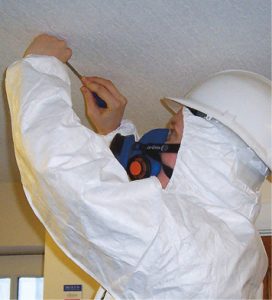 RSK Asbestos Managing Director Melissa Fox advises that, with the Health and Safety Executive (HSE) recording more than 5,000 asbestos-related deaths every year, there needs to be a real commitment to safety and compliance and the requirements of the Control of Asbestos Regulations 2012(i)
RSK Asbestos Managing Director Melissa Fox advises that, with the Health and Safety Executive (HSE) recording more than 5,000 asbestos-related deaths every year, there needs to be a real commitment to safety and compliance and the requirements of the Control of Asbestos Regulations 2012(i)
When it comes to building management, there are a great many risks to consider, but the presence of asbestos can elevate the management of this issue to the top of the list. Asbestos has been a feature of responsible building management for so long that there is a very real danger of focusing on completing an asbestos management survey solely as part of a commitment to compliance, but it’s important to understand that completing the survey should not be viewed as something to be ticked off a to-do list and filed away once accomplished. It serves us best when it is used to create an on-site management plan to be used as a living document that directs the actions of everyone who interacts with the building in such a way that they may disturb materials containing asbestos, creating a risk of exposure.
Having an in-depth understanding of what the survey covered (or not) and considering any further courses of action are critical.
This may include:
- Removal or repair of identified asbestos-containing materials, if advised.
- Ongoing regular inspection of such materials to ensure their condition remains satisfactory.
- Awareness training for those on-site who need to be aware of all risks present.
- Production and implementation of a site management plan, so that any site visitors or contractors can be made aware of any risks they might encounter.
- Further surveys that may be needed to facilitate any more-intrusive building works of areas that don’t fall within the scope of the management survey.
ASBESTOS STATISTICS
The HSE report Asbestos-related disease statistics in Great Britain, 2022(ii) advises that the number of asbestos-related deaths per year (more than 5,000) has been consistent for several years. This emphasises the ongoing challenge in ensuring that everyone with potential risk of exposure is protected and that those with responsibility for facilities management understand how to achieve this.
The report notes that the “inhalation of asbestos fibres can cause cancers such as mesothelioma and lung cancer, and other serious lung diseases such as asbestosis and pleural thickening”.
With asbestos-related diseases typically taking years to develop, the current HSE statistics are acknowledged as reflecting the ongoing legacy of the past. The significant increase in asbestos-related disease in Great Britain over the last few decades has been directly linked to the post-Second World War building industry’s widespread use of products containing asbestos.
 In considering the risks associated with asbestos, it is important to understand that materials containing asbestos deteriorate over time, which could result in fibres being released.
In considering the risks associated with asbestos, it is important to understand that materials containing asbestos deteriorate over time, which could result in fibres being released.
INCREASING AWARENESS
Managing wider activity in a building in which asbestos has been identified is crucial, and failure to comply with regulations can potentially put others at risk of the exposure that HSE warns about. This includes employees, contractors and site visitors.
Since a lack of awareness and management of materials containing asbestos within buildings could lead to it becoming damaged during planned works, the asbestos survey must govern any and all building or repair work. Tradespeople are considered to be at the highest risk, and this should be recognised within building management plans.
To ensure everyone with responsibility and risk associated with asbestos is safe and compliant, it is necessary to:
- Increase awareness of legislative requirements so that everyone has a clear idea of what is required of them.
- Train relevant people on-site to help them to appreciate and manage the risk.
- Ensure ongoing monitoring schemes are put in place to record the condition of any asbestos on site.
- Instruct the production of an asbestos management survey and a site-specific asbestos management plan and to read and action any recommendations in the report.
- Make all contractors working on-site aware of any risks within their work areas.
- Undertake project-specific surveys before intrusive works and ensure that everyone understands any new risks that have been identified and that the site’s asbestos register is updated accordingly.
- Check the competency of the contractors who are employed on-site to ensure they have the required understanding of asbestos-related risk.
Those who have worked to increase their knowledge and understanding of the complexity of asbestos management are more likely to be keeping their employees safe, which in turn makes employees feel valued and promotes safer working practices. A positive compliance-based culture ensures that risks within the workplace are kept to a minimum, which greatly reduces the likelihood of an incident occurring.
 In association with https://rskgroup.com
In association with https://rskgroup.com
Melissa Fox, Managing Director of RSK Asbestos (part of RSK Environment), has a Certificate of Competence in Asbestos from the British Occupational Hygiene Society and is a Member of the Faculty of Asbestos Assessment and Management.
(i) https://www.hse.gov.uk/asbestos/regulations.htm
(ii) https://www.hse.gov.uk/statistics/causdis/asbestos-related-disease.pdf




